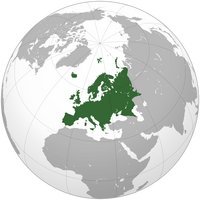| Republic of Ireland Poblacht na hÉireann (Irish) Timeline: Nuclear Apocalypse: 2014
OTL equivalent: Republic of Ireland and Northern Ireland | ||||||
|---|---|---|---|---|---|---|
|
||||||
| Anthem: "Amhrán na bhFiann" "The Soldier's Song" |
||||||
| Capital (and largest city) | Dublin | |||||
| Official languages | Irish and English | |||||
| National language | Irish | |||||
| Ethnic groups (2017) | 87% Irish 5% Scots and Welsh 4% French 2% Others |
|||||
| Religion | Roman Catholicism | |||||
| Demonym | Irish | |||||
| Government | Unitary parliamentary republic | |||||
| - | President | Michael D. Higgins | ||||
| - | Taoiseach | Leo Varadkar | ||||
| - | Tánaiste | Frances Fitzgerald | ||||
| Legislature | Oireachtas | |||||
| - | Upper house | Seanad | ||||
| - | Lower house | Dáil | ||||
| Establishment | ||||||
| - | Proclamation | 24 April 1916 | ||||
| - | Declaration of Independence | 21 January 1919 | ||||
| - | Anglo-Irish Treaty | 6 December 1921 | ||||
| - | 1922 Constitution | 6 December 1922 | ||||
| - | 1937 Constitution | 29 December 1937 | ||||
| - | Republic Act | 18 April 1949 | ||||
| - | Unification | 6 December 2016 | ||||
| Area | ||||||
| - | Total | 84,421 km2 32,595 sq mi |
||||
| - | Water (%) | 2.00 | ||||
| Population | ||||||
| - | 2017 estimate | 4,500,000 | ||||
| Currency | Saorstát pound (IEP) |
|||||
| Time zone | GMT | |||||
| - | Summer (DST) | WEST (UTC+1) | ||||
| Date formats | dd/mm/yyyy | |||||
| Drives on the | left | |||||
| Calling code | +353 | |||||
| Patron saint | Saint Patrick | |||||
Ireland, officially the Republic of Ireland, is an island nation located off the coast of mainland Europe in the North Atlantic.
History[]
A unified independent Irish sovereign state originated as the Irish Free State in 1922 after three years of rebellion and later civil war. When Ireland gained independence, it held the status of a British Commonwealth Dominion until a new constitution was adapted in 1937. Ireland would not be officially declared a republic until 1949.
Ireland held no formal relations with Northern Ireland throughout much of the twentieth century. In fact, Northern Ireland was divided by a brutal civil war caused by separate loyalties. Some supported unifying with the republic while others wanted to remain British subjects. The governments of the Republic of Ireland and the United Kingdom worked with parties in Northern Ireland to achieve a resolution to the civil conflict, best known as "the Troubles". Since the Good Friday Agreement was signed in 1998, the Northern Ireland Executive and the government of Ireland worked closely on a number of policy areas under the North-South Ministerial Council created by the Agreement.
Despite begin a member-state of both the European Union and the Partnership for Peace (a NATO program), Ireland has followed a policy of military neutrality. The Republic of Ireland was spared from the Nuclear Exchange the destroyed much of the Northern Hemisphere.
Government[]
Ireland is a unitary republic with a parliamentary system. The legislature, the Oireachtas, consists of a lower house, Dáil Éireann, an upper house, Seanad Éireann, and an elected President (Uachtarán) who serves as the largely ceremonial head of state, but with some important powers and duties. The head of government is the Taoiseach (Prime Minister, literally 'Chief', a title not used in English), who is elected by the Dáil and appointed by the President; the Taoiseach in turn appoints other government ministers.
See Also[]
| |||||||||
| ||||||||||||||||||||||





